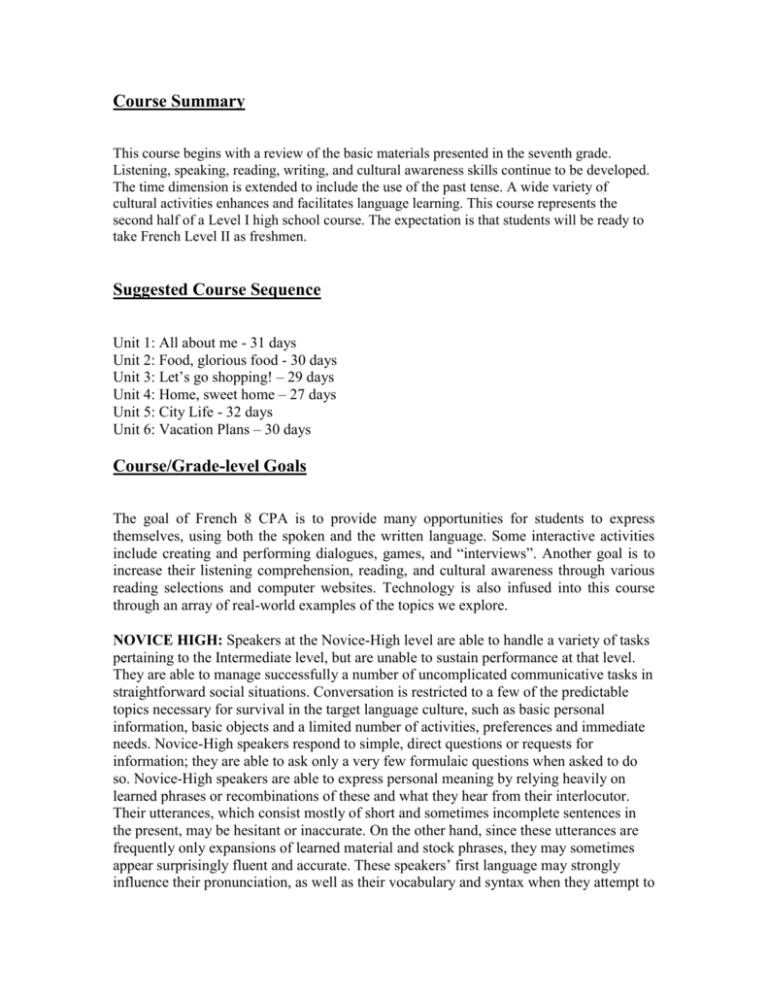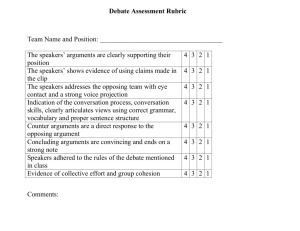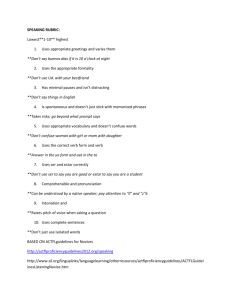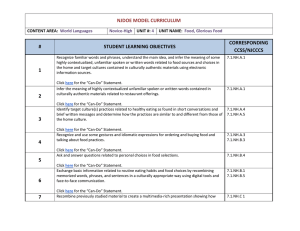8 grade course summary - Midland Park Public Schools
advertisement

Course Summary This course begins with a review of the basic materials presented in the seventh grade. Listening, speaking, reading, writing, and cultural awareness skills continue to be developed. The time dimension is extended to include the use of the past tense. A wide variety of cultural activities enhances and facilitates language learning. This course represents the second half of a Level I high school course. The expectation is that students will be ready to take French Level II as freshmen. Suggested Course Sequence Unit 1: All about me - 31 days Unit 2: Food, glorious food - 30 days Unit 3: Let’s go shopping! – 29 days Unit 4: Home, sweet home – 27 days Unit 5: City Life - 32 days Unit 6: Vacation Plans – 30 days Course/Grade-level Goals The goal of French 8 CPA is to provide many opportunities for students to express themselves, using both the spoken and the written language. Some interactive activities include creating and performing dialogues, games, and “interviews”. Another goal is to increase their listening comprehension, reading, and cultural awareness through various reading selections and computer websites. Technology is also infused into this course through an array of real-world examples of the topics we explore. NOVICE HIGH: Speakers at the Novice-High level are able to handle a variety of tasks pertaining to the Intermediate level, but are unable to sustain performance at that level. They are able to manage successfully a number of uncomplicated communicative tasks in straightforward social situations. Conversation is restricted to a few of the predictable topics necessary for survival in the target language culture, such as basic personal information, basic objects and a limited number of activities, preferences and immediate needs. Novice-High speakers respond to simple, direct questions or requests for information; they are able to ask only a very few formulaic questions when asked to do so. Novice-High speakers are able to express personal meaning by relying heavily on learned phrases or recombinations of these and what they hear from their interlocutor. Their utterances, which consist mostly of short and sometimes incomplete sentences in the present, may be hesitant or inaccurate. On the other hand, since these utterances are frequently only expansions of learned material and stock phrases, they may sometimes appear surprisingly fluent and accurate. These speakers’ first language may strongly influence their pronunciation, as well as their vocabulary and syntax when they attempt to personalize their utterances. Frequent misunderstandings may arise but, with repetition or rephrasing, Novice-High speakers can generally be understood by sympathetic interlocutors used to non-natives. When called on to handle simply a variety of topics and perform functions pertaining to the Intermediate level, a Novice- High speaker can sometimes respond in intelligible sentences, but will not be able to sustain sentence level discourse. Interpretive Mode: The Interpretive Mode of communication: students demonstrate understanding of spoken and written communication within appropriate cultural contexts. Examples of this kind of "one-way" reading or listening include cultural interpretations of printed texts, videos, online texts, movies, radio and television broadcasts, and speeches. Beyond the Novice level, "interpretation" differs from "comprehension" because it implies the ability to read or listen "between the lines" and "beyond the lines." Interpretive Mode Course Goals: By the end of the French 8 course students will be able Recognize familiar words and phrases, understand the main idea, and infer the meaning of some highly contextualized, unfamiliar spoken or written words contained in culturally authentic materials such as books, audio recordings, videos, games, and realia that have been produced for use by native speakers of the target language using electronic information sources such as podcast, video-casts, and websites related to targeted themes. Demonstrate comprehension of a series of oral and written directions, commands, and requests through appropriate physical response. Recognize some common gestures and cultural practices associated with target culture(s). Identify people, places, objects, and activities in daily life based on oral or written descriptions. Demonstrate comprehension of short conversations and brief written messages on familiar topics. Identify the main idea and other significant ideas in readings from age- and levelappropriate books, audio recordings, videos, games, and realia that have been produced for use by native speakers of the target language. Interpersonal Mode: The Interpersonal Mode of communication: Students engage in direct oral and/or written communication with others. Examples of this "two-way" communication include conversing face-to-face, participating in online discussions or videoconferences, instant messaging and text messaging, and exchanging personal letters or e-mail messages. For more on the interpersonal mode of communication: Interpersonal Mode Course Goals: -Use digital tools, such as blogs, e-mail, and video-conferencing to exchange basic information by recombining memorized words, phrases, and sentences on topics related to self and targeted themes. -Give and follow a series of oral and written directions, commands, and requests for participating in age- and level- appropriate classroom and cultural activities. -Imitate appropriate gestures, intonation, and common idiomatic expressions of the target culture(s)/language during daily interactions. - Ask and respond to questions, make requests, and express preferences in various social situations. - Converse on a variety of familiar topics and/or topics studied in other content areas. Presentational Mode: The Presentational Mode of communication: in which students present, orally and/or in writing, information, concepts and ideas to an audience of listeners or readers with whom there is no immediate interaction. Examples of this "oneto-many" mode of communication include a presentation to a group, posting an online video or webpage, creating and posting a podcast or video-cast, and writing an article for a newspaper. Presentational Mode Course Goals: -Recombine basic information at the word and sentence level related to self and targeted themes to create a multimedia-rich presentation (combination of text, audio, still images, video, interactivity and animation) on targeted themes to be shared virtually with a target language audience. -Create and present brief messages, poems, rhymes, songs, short plays, or role-plays using familiar vocabulary orally or in writing. -Describe in writing people and things from the home and school environment. -Tell or retell stories from age- and level-appropriate, culturally authentic materials such as books, audio recordings, videos, games, and realia that have been produced for use by native speakers of the target language orally or in writing. -Tell or write about cultural products associated with the target culture(s), and simulate common cultural practices.






